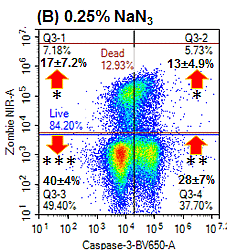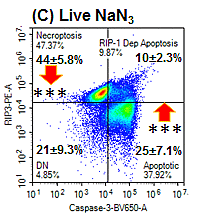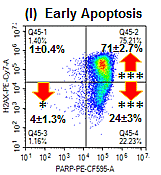Jurkat cells treated with 0.25% sodium azide for 24 h induce a high degree of oncosis which can be immunophenotyped by the use of a fixable cell viability dye (e.g. Zombie NIR, BioLegend) and active caspase-3-BV650 (BD). This shows that live cells are Zombie-ve/Caspase-3-ve, early apoptosis are Zombie-ve/Caspase-3+ve, late apoptosis Zombie+ve/Caspase-3+ve and oncotic cells Zombie+ve/Caspase-3-ve or cells that have died independently of caspase-3, see figure. Prior blockade of apoptosis induced by sodium azide can be blocked by prior treatment with pan-caspase blocker, zVAD, see figure.
Further immunophenotyping with RIP3 a protein involved in necroptosis by it phosphorylation and up-regulation in conjunction with Caspase-3 allows oncotic cells to be subdivided into RIP3+ve/-ve phenotypes, see figure. Additional antibodies for pH2AX and celaved PARP can further identify H2AX (DDR), parthanatos and cleaved PARP as well as negative cells so that 8 populations of oncotic cells can be identified, see figure.



